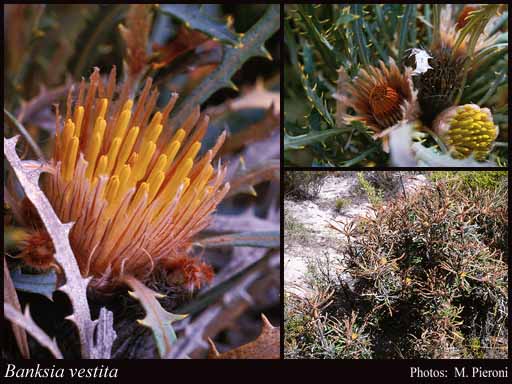- Reference
- Austral.Syst.Bot. 20:71 (2007)
- Conservation Code
- Not threatened
- Naturalised Status
- Native to Western Australia
- Name Status
- Current
Low, spreading or erect, lignotuberous shrub, 0.4-1.2 m high. Fl. yellow, Jan or Apr or Aug. Grey or yellow sand, sandy loam with gravel.

Scientific Description
Shrubs, 1-1.5 m high; branchlets hairy. Leaves petiolate, alternate, 50-130 mm long, 7-14 mm wide, hairy; petiole 25-55 mm long; lamina flat, once divided, pinnately divided, shallowly divided, teeth pointing outwards, with 5-10 lobes on each side, the margins recurved. Inflorescences pubescent (with soft, straight, erect hairs), yellow; innermost bracts 20-25 mm long, hairy. Perianth 27-32 mm long, glabrous, without awns; pistil 26-31 mm long, straight, style glabrous. Follicles hairy, pubescent (with soft, straight, erect hairs), obovate, 10-14 mm long. Flowers in January, February, March or April. Occurs in the South-west (SW) Botanical Province(s), in the Geraldton Sandplains (GS), Swan Coastal Plain (SWA), Avon Wheatbelt (AW), Jarrah Forest (JF) or Mallee (MAL) IBRA subregion(s).
Distribution
- IBRA Regions
- Avon Wheatbelt, Geraldton Sandplains, Jarrah Forest, Mallee, Swan Coastal Plain.
- IBRA Subregions
- Dandaragan Plateau, Katanning, Lesueur Sandplain, Merredin, Northern Jarrah Forest, Western Mallee.
- Local Government Areas (LGAs)
- Beverley, Bruce Rock, Carnamah, Coorow, Corrigin, Cunderdin, Dandaragan, Dowerin, Dumbleyung, Gingin, Kellerberrin, Kulin, Merredin, Narrogin, Pingelly, Quairading, Tammin, Wandering, Wickepin.